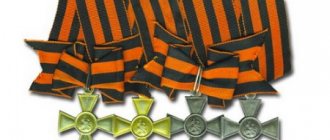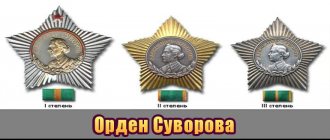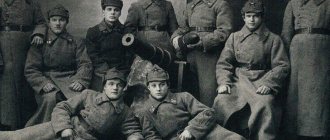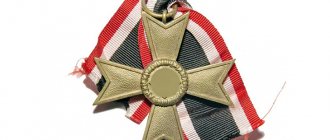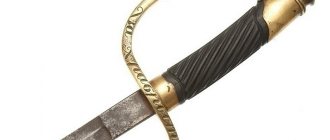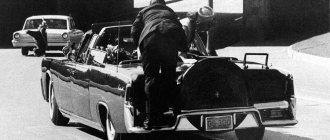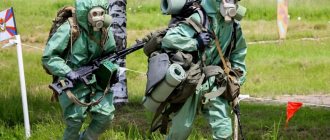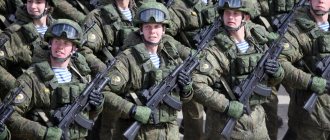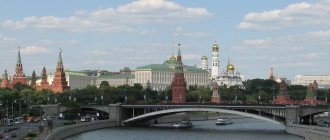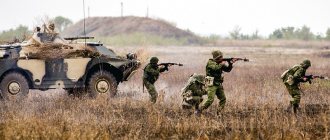Awards during the Russian Empire
The decision to introduce the Order of St. George into the system of awards of the Russian Empire was made directly by Catherine II on November 26, 1769. Officers of the Russian Empire and generals were awarded for achievements of a military nature.
According to the statute, division into 4 degrees was assumed, so the order was awarded taking into account the gradual factor. However, this was carried out outside the hierarchical structure of the state awards that existed at that time. Ultimately, it was this order that turned out to be the main military award in Russia.
Preparations for the establishment of the order took several years.
The idea of establishing a special award, awarded exclusively for military merits, came to Empress Catherine II immediately after her accession to the throne. The first draft of the Order of St. George - a Christian martyr, patron of the military, especially revered in Russia - was prepared by 1765. The Empress, however, was not satisfied with the proposal, and work on the order lasted another four years.
Officially, the statute of the Order of the Holy Great Martyr George was signed by Empress Catherine II in the Winter Palace on November 26 (December 7, new style) 1769.
The Divine Liturgy was served in the palace church, and the insignia of the order - a cross, a star and a ribbon - were consecrated.
The establishment of the order was accompanied by great celebrations and an artillery salute.
Catherine II bestowed the badge of the Order of the 1st degree on herself in honor of the establishment of a new award. The self-imposition of the award will be repeated only once more in history - in 1869, Alexander II will celebrate the 100th anniversary of the order.
The badge of the order was an equal-armed cross with flared ends, covered with white enamel. In the central medallion on the front side there was an image of St. George on a white horse, on the reverse side there was a monogram “SG”, that is, “St. George”. The tape is two-color - three black and two orange alternating stripes. The star was four-pointed, gold, with a monogram and a motto in .
Features of the award
Orders of the 1st and 2nd degrees were applied only on the basis of the decision of the monarch himself. The remaining degrees from 1833 were characterized by the need to represent the direct superiors of the recipient. After this, there was a discussion of the ideas by the Duma, which included holders of the order, commanders of armies, corps or squadrons and fleets. To make a decision, 2/3 or more of all the votes of the members of the St. George Duma were required. The final approval was made directly by the Russian Tsar himself.
During the years when Paul I was on the throne (1796-1801), the order was not awarded. The restoration of the practice of awarding occurred after Alexander I adopted a special resolution on December 12, 1801. Until 1805, the Order of St. George, 4th degree, was awarded to persons who participated in military events and served in the ranks of chief officers for 25 years.
The Order was also given to naval officers who did not participate in battles, but went through 18 or 20 military campaigns. The inscriptions were fixed on the transverse surfaces of the ends of the cross. And on May 15, 1855, Alexander II decided to abolish these statutory articles, after which the Order of St. George was awarded exclusively for special courage and bravery.
Why was the order awarded?
According to the statute of Empress Catherine II, the award was given for special distinctions in battles, as well as for length of service in officer ranks: 25 years in field service or 18 campaigns in the sea.
“Neither high breed nor wounds received in front of the enemy give the right to be awarded this order, but it is given only to those who have distinguished themselves by a particularly courageous act; this order should never be removed: for it is acquired by merit,” - from the statute of the order in 1769.
Appearance of the awards presented
The order had the appearance of a golden cross, which had flared ends. To cover its sides, white enamel was used, distinguished by a golden border at the edges. The medallion that decorated the middle of the cross contained an image of the coat of arms of Moscow. It featured the appearance of St. George the Victorious on horseback.
The silver armor of St. George the Victorious and the golden diadem are noteworthy. The saint pierced the black serpent with his spear. The reverse is decorated with the saint’s original monogram in the form of a combination of letters – SG.
Since 1845, the award of the order to non-Christians was allowed, but the center of the cross was different - in the place of George there was a Russian state sign in the form of an eagle. In the center of a golden star in the shape of a rhombus with 4 ends was the SG monogram. It was applied to a golden round field. There was a black hoop around the circumference. On it was the motto “For Service and Bravery,” written in gold letters. The ribbon was decorated with 3 black and 2 orange stripes.
Taking into account the degree, the method of wearing the award was determined:
- For the 1st degree it was supposed to be worn in the thigh area. The order was attached to a ribbon, the width of which was 10 cm. It was worn under the uniform. This had to be done over the shoulder on the right. The star should have been on the left chest. The Order was worn under the star of St. Andrew the First-Called.
- The order of the second degree was worn on a ribbon, the width of which was 5.5 cm. It was worn around the neck. Along with the order, the presence of a star was provided.
- The order of the 3rd degree did not have a star, and the cross itself had to be worn around the neck. For this purpose, a tape 4.3 cm wide was used.
- The Order of the 4th degree was to be worn in a buttonhole on the chest using a 2.2-centimeter ribbon.
"A bird instead of a horseman"
In 1807, to Emperor Alexander I with a proposal to “introduce a 5th class or a special branch of the Military Order of St. George for soldiers and other lower military ranks.”
Article on the topic
Red Order. How did the first Soviet award appear?
In February 1807, Alexander I approved the insignia of the Military Order for lower ranks “For undaunted courage,” which later received the unofficial name “Soldier George.” The manifesto ordered that the insignia of the Military Order be worn on a ribbon of the same colors as the Order of St. George.
This award was given much more often - during the reign of Alexander I alone there were more than 46 thousand such awards. Initially, “soldier George” did not have degrees. They were introduced by imperial decree in 1856.
An interesting point is that many Muslims and representatives of other faiths fought in the ranks of the Russian army. Since St. George is a Christian saint, in order not to offend representatives of other faiths, for these cases the appearance of the award was changed - to non-Christians it was presented with the image of a double-headed eagle, and not St. George the Victorious.
This delicacy, however, was not appreciated by everyone. The brave mountaineers even asked with some resentment: “Why do they give us crosses with a bird, and not with a horseman?”
Privileges received by cavaliers
The provisions of the Statute of 1769 assumed the obligation of cavaliers to wear orders without removing them, since they were awarded for merit. The cross could be used by gentlemen to design family coats of arms and seals. However, decoration with precious stones was not allowed.
In 1833, a Statute was adopted, according to which holders of the St. George's Award received a special type of clothing. It was a super vest made of orange velvet. It was decorated with golden fringe. In the chest and back area there were black crosses decorated with velvet.
According to the award rules, the gentlemen did not have to pay monetary contributions. At the same time, seniors within each degree had the opportunity to receive pensions. These pension payments after the death of the cavaliers could be received by their widows. If the recipient did not have the right of hereditary nobility, it was automatically assigned after receiving the order. In addition, for cavaliers, a reduction in the waiting time for receiving the next rank was envisaged. In case of resignation, the right to wear a military uniform was retained.
Additionally, the right to annual leave arose:
- 2 months - annually;
- 4 months - 1 time every 2 years.
Along with the right to benefit from free treatment and travel on preferential terms, since 1849, the Knights of St. George received the perpetuation of their names and surnames on marble surfaces. Children of persons who received the St. George Cross enjoyed benefits for education.
Persons who received the award
When Catherine II created this award, the sign of the first degree was assigned to her. The reigning emperor was recognized as the grandmaster of the order. F. Fabritian became the first holder of the order for successful heroic actions in confrontation with a more powerful enemy and for the capture of Galati.
The Order of the 1st degree was awarded to the general-in-chief:
- P. Rumyantsev in 1770 (battle of Cahul);
- A. Orlov for the victory over enemy ships of the Turkish fleet during the Battle of Chesme;
- P. Panin, who led the army of the empire on the Crimean peninsula.
The 1st degree award was also awarded to G. Potemkin and A. Suvorov in 1788 and 1789, respectively. The Order was also awarded to foreign citizens.
The Order of the 2nd degree was awarded to F. Ushakov (1790), Prince P. Bagration (1805) and Count M. Platov (1807). The cavaliers include Prince M. Vorontsov, N. Raevsky and A. Ermolov.
Especially many holders of the Order appeared after the events of 1812.
The First World War is also notable for the appearance of cavaliers of the order - they received the 2nd degree award for accomplished feats and military merits 4 times. The 3rd degree badge was awarded 71 times, and the 4th degree - over 3.5 thousand times. The St. George ribbon was decorated with 5 gold crosses for the capture of Ochakov, as well as numerous imperial medals.
The First Cavalier and the Great Four
Only officers were awarded the Order of St. George. The first recipient of the award was Lieutenant Colonel Fyodor Ivanovich Fabritsian . It was impossible to find a more worthy candidate for this. Fyodor Fabritsian, a Courland nobleman, enlisted as a soldier in 1749. After going through several military campaigns, Fabritian rose to high ranks, demonstrating personal courage. Contemporaries noted that he was extremely concerned about the needs of his soldiers and took care of them.
On November 11, 1769, commanding a special detachment of Jaeger battalions and part of the 1st Grenadier Regiment numbering 1,600 people, Lieutenant Colonel Fabritian completely defeated a Turkish detachment of 7,000 people and occupied the city of Galati. For this feat, he was awarded the Order of St. George, and not the 4th, but immediately the 3rd degree.
Subsequently, Fyodor Fabritsian became a general and commanded the Russian army in the North Caucasus.
In the entire history of the Order of St. George, only 25 people were awarded its 1st degree, and 125 people received the 2nd degree award. The 3rd and 4th degrees were awarded much more often, the total number of recipients was about 10 thousand people. Moreover, most of the orders of the 4th degree, about 8000, were received not for exploits, but for length of service.
Knights of the Order of St. George were entitled to an annual pension - 700 rubles for the 1st degree, 400 rubles for the 2nd, 200 and 100 rubles for the 3rd and 4th degrees, respectively.
Only four people were holders of all four degrees of the Order of St. George - Field Marshals Mikhail Kutuzov , Mikhail Barclay de Tolly , Ivan Paskevich and Ivan Dibich .
Establishment of the Military Order
On February 13, 1807, Tsar Alexander I established a new insignia - the Military Order. It was awarded to the lower ranks of the army and navy. The award required a vote of company commanders and regimental staff officers. Each applicant was nominated for the award by his immediate commander.
The order was made in the form of a silver cross on a St. George ribbon with a fastening in the buttonhole. The design of the center of the cross was represented by the image of St. George. The reverse was decorated with his monogram.
In 1809, the number for inclusion in the list of cavaliers was introduced. It was placed on the back of the cross. When non-Christians were awarded, the Russian eagle was placed in the center. The order was worn continuously until the moment of awarding the Order of St. George after receiving the rank of officer.
The degrees of the Military Order were introduced by Alexander II on March 19, 1856. There were four in total. The award of the first and second degrees was in the form of a gold cross, and the order of the third and fourth degrees was represented by a silver cross. For their lavalier wear, the St. George ribbon was used, and a bow was provided for the 1st and 3rd degrees. Since 1913, the order received the name "St. George's Cross".
The person who received the order immediately had their salary increased. It was paid throughout life. Since 1808, gentlemen were exempted from corporal punishment, and in 1815, taxation was lifted for them. In 1913, it was decided to pay an additional amount of money every year in the amount of 36-120 rubles.
Order of St. George.
“We are Russians, what a delight!” (A.V. Suvorov).
Order of St. George.
Date of establishment: November 26 (December 7), 1769 Founder: Catherine II Status: the highest military order for military merit Motto: “For service and courage” Number of degrees: 4 Ribbon: yellow-black Statute: the highest military order for military merit Rules wearing: First degree - a star on the chest on the left and a large cross on a garter over the shoulder on the right; Second degree - a star on the left and a large cross on the chest, located on a ribbon around the neck; Third degree - a small cross on a ribbon around the neck; The fourth degree is a small cross in the buttonhole or on the bar.
Empress Catherine II established the highest officer order of the Russian army - the Order of the Holy Great Martyr and Victorious George. The design of the order was developed by the hero of the Seven Years' War, Count Z.G. Chernyshev.
According to the statute, the Order of St. George was intended to reward military ranks “... for courage, zeal and zeal for military service and for encouragement in the art of war” and was immediately after the Order of St. Andrew the First-Called in importance. It was established that “...neither high family, nor previous merits, nor wounds received in battles are accepted in respect when awarding the Order of St. George for military exploits; it is awarded only to the one who not only fulfilled his duty in everything according to the oath , honor and duty, but on top of this he marked himself for the benefit and glory of Russian weapons with a special distinction.”
The order had four degrees:
Order and Star of St. George, 1st degree.
Order of St. George, 1st degree.
1st degree: cross, star and ribbon. The cross is gold, covered on both sides with white enamel, with a gold border around the edges. In the central circle, filled with red enamel, there is an image of St. George on a white horse, slaying a dragon with a spear. On the reverse side, in a white circle, is the monogram of St. George (in the intertwined letters SG). The star of the order is golden quadrangular (diamond-shaped), formed by 32 golden (solar) rays emanating from the center. In the middle of it, on a gold background, there is a similar monogram of St. George, and on a black hoop around it, the motto of the Military Order “For Service and Bravery” is written in gold letters. The cross was worn on a 10-11 cm wide moire ribbon with three black and two orange stripes, which was worn over the right shoulder.
Order of St. George, 2nd degree.
2nd degree: golden cross and golden star, similar to the first degree. The cross was worn around the neck on a narrower medal ribbon.
Order of St. George, 3rd degree.
3rd degree: golden cross, similar to the senior degrees, but smaller in size. Worn around the neck on an order ribbon.
Order of St. George, 4th degree.
Order of St. George, 4th degree.
Order of St. George, 4th degree for non-believers.
4th degree: a golden cross slightly smaller than that of the third degree. Worn in a buttonhole or on the left side of the chest on a narrow order ribbon.
St. George's ribbon and the Order of St. George.
The colors of the St. George Ribbon, as some researchers believed, combined “the color of gunpowder and the color of fire...”, while others rightly pointed out that black and yellow are the state Russian colors, and it is not for nothing that the Russian coat of arms was described as follows: “A black eagle, with a crown on the heads, and at the top in the middle there is a large Imperial crown - gold, in the middle of the same eagle George, on a white horse, defeating the serpent, the epancha and spear are yellow, the crown is yellow, the serpent is black."
The Knight of St. George was granted the rights of hereditary nobility, the possibility of preferential promotion to the next rank of his choice (but only once), upon retirement, to wear a military uniform (even if he had not served the required 10-year term for this), to place on his personal coats of arms and seals the sign of the Military Order. The senior cavaliers received pensions (in addition to the salary and serviced pension): for the 1st degree - 6 pensions of 1000 rubles each, for the 2nd degree - 25 pensions for 400 rubles each, for the 3rd degree - 50 pensions 200 rubles each, and for the 4th degree - 300 pensions of 150 rubles each.
Catherine 2 reserved the award of the Order of St. George of the first two degrees to herself personally, the discussion of the rights to receive the order of the 3rd or 4th degree was assigned to the land and naval colleges, and since 1782 this responsibility became the prerogative of the Cavalier Chapter or the St. George's Duma. In 1913, the right to award the 4th degree was given to army and navy commanders (as provided by the State Duma). Regimental priests could be awarded for their exploits with gold pectoral crosses on the St. George ribbon.
Especially for the meeting of the Cavalry Duma, a special building was established, which housed the administration of the order, the archive, the press and the order’s treasury, and Nicholas I built the St. George Hall in the Grand Kremlin Palace. There were also St. George's Halls in St. Petersburg in the Winter Palace and in the General Staff building.
The very first holder of the Order of St. George (not counting, of course, Catherine II herself) was on December 8, 1769, Lieutenant Colonel of the 1st Grenadier (later Life Guards Grenadier) Regiment Fyodor Ivanovich Fabritsian - “... for the defeat of the detachment entrusted to him (detachment) 1600 people near the city of Galati, November 15, 1769, very crowded against the number of enemy troops and taking possession of it.” The brave warrior received the 3rd degree of the order.
The Order of the 4th degree was first received by the Prime Major of the Kargopol Carabinieri Regiment, Reinholt von Patkul, awarded on February 3, 1770 “... for the excellent courage he showed against the enemy during the defeat of a very populous party of Polish rebels on January 12, 1770 at the town of Dobre.”
The Order of the 2nd degree was first awarded on July 27, 1770 to Lieutenant General Pyotr Grigorievich Plemyannikov “... for the example of courage that served his subordinates in overcoming labor, fearlessness and winning victory over the enemy on July 21, 1770 near Cahul.”
The first knight of the 1st degree was Pyotr Aleksandrovich Rumyantsev for the crushing defeat of Turkish troops at Ryaba Mogila, Larga and Kagul (summer 1770). In total, 25 people received 1st degree of the Russian Military Order, including Catherine II and Alexander II. Among the eight foreign holders of the order were Field Marshal Blücher (Prussia) and Field Marshal General Wellington (Great Britain) who defeated Napoleon at the Battle of Waterloo on June 18, 1815.
Full Knights of the Order of St. George, i.e. In the entire history of Russia, there were four who received badges of all degrees: - Field Marshal Mikhail Illarionovich Golenishchev-Kutuzov, Prince of Smolensk; - Field Marshal General Count Mikhail Bogdanovich Barclay de Tolly; - Field Marshal General Count Ivan Fedorovich Paskevich-Erivansky; - Field Marshal General Ivan Ivanovich Dibich-Zabalkansky.
Over the 148 years of its existence, only 121 people have been awarded the Order of St. George, 2nd degree. Infantry general Mikhail Dmitrievich Skobelev had three Georges. During its entire existence, only 647 people received the Order of the 3rd degree. Over the course of a hundred years, from 1769 to 1869, only 2,239 people, including 166 foreigners, received the Order of St. George, 4th degree.
Special insignia were five gold crosses worn on St. George ribbons (they were awarded to officers nominated for the Order of St. George or St. Vladimir, but who did not receive them): - “For service and bravery - Ochakov was captured on December 5, 1788”; - “For excellent courage - Ishmael was captured on December 11, 1790”; - “For labor and courage - Prague was taken on October 24, 1794”; — “Victory at Preussisch-Eylau 27 Gen.” 1807"; — “For excellent courage during the capture of Bazardzhik by attack on May 22, 1810.”
In 1805, the first collective St. George's awards appeared - St. George's Banners (standards) and St. George's Trumpets. The badge of the Order of St. George was installed in the spear of the banner staff, narrow St. George ribbons with lanyards were hung on the top, and an inscription was made on the panel, for which such a distinction was received. The St. George trumpets were made of silver, with the St. George Cross and the corresponding inscription on them, and order ribbons were hung on them. In 1814, the St. George's Bunchuk of the Don Army was established. In 1864, St. George's buttonholes were installed for lower ranks, in 1878 - St. George's ribbons for military sailors (still preserved on the caps of sailors of the guards units).
Other awards with St. George's ribbon.
The highest collective award was established in 1878. The banners and standards were decorated with a wide St. George ribbon, a cross and a star of the 1st degree of the Military Order. This award was given to the 17th Nizhny Novgorod Dragoon Regiment and the 18th Seversky Dragoon Regiment, which had especially distinguished itself in the Russian-Turkish War. In 1913, the Golden Arms of St. George were added to the Military Order.
Golden Arms of St. George "For Bravery".
St. George's Cross.
The insignia of the Military Order is an award assigned to the Order of St. George for lower ranks from 1807 to 1917 for military merits and for courage shown against the enemy. The insignia of the Military Order was the highest award for soldiers and non-commissioned officers. From June 24, 1917, it could also be awarded to officers for feats of personal bravery by honoring a general meeting of soldiers of a unit or sailors of a ship.
Since 1913, the official name has been enshrined in the statute - St. George's Cross. Until 1913, in addition to the official one, it had other, unofficial names: St. George's Cross of the 5th degree, soldier's St. George's Cross, soldier's George (“Egory”), etc.
The idea of establishing a soldier’s award was expressed in a note submitted on January 6, 1807 addressed to Alexander I (author unknown), which proposed establishing “... a 5th class or a special branch of the Military Order of St. George for soldiers and other lower military ranks... which may consist , for example, in a silver cross on the St. George ribbon, threaded into a buttonhole.” The insignia of the Military Order was established on February 13 (25), 1807, by the manifesto of Emperor Alexander I, as a reward for lower military ranks for “undaunted courage.” Article 4 of the manifesto ordered that the insignia of the Military Order be worn on a ribbon of the same colors as the Order of St. George. The badge had to be worn by its owner always and under all circumstances, but if the holder of the badge was awarded the Order of St. George, in 1807-1855 the badge was not worn on the uniform.
When it was established, the Soldier's Cross did not have degrees, and there were also no restrictions on the number of awards one person could receive. At the same time, a new cross was not issued, but with each award the salary increased by a third, to double the salary. Unlike the officer's order, the soldier's award was not covered with enamel and was minted from silver of the 95th standard (modern 990th standard).
By decree of July 15, 1808, holders of the insignia of the Military Order were exempted from corporal punishment. The insignia could be confiscated from the recipient only by court and with mandatory notification of the emperor.
There is a known case of a general being awarded a soldier's award. It became M.A. Miloradovich for the battle with the French in the soldier ranks near Leipzig. Emperor Alexander I, who observed the battle, presented him with a silver cross.
In January 1809, cross numbering and name lists were introduced. By this time, about 10 thousand signs had been issued. By the beginning of the Patriotic War of 1812, the Mint had produced 16,833 crosses. The statistics of awards by year are indicative: 1812 - 6783 awards; 1813 - 8611 awards; 1814 - 9345 awards; 1815 - 3983 awards; 1816 - 2682 awards; 1817 - 659 awards; 1818 - 328 awards; 1819 - 189 awards.
From March 19, 1855, the badge was allowed to be worn on the uniform by its owners who were subsequently awarded the Order of St. George.
On March 19, 1856, four degrees of the sign were introduced by imperial decree. The badges were worn on the St. George ribbon on the chest and were made of gold (1st and 2nd art.) and silver (3rd and 4th art.). Externally, the new crosses differed in that the words “4 degrees” and “3 degrees” were now placed on the reverse. etc. The numbering of characters began anew for each degree. Awards were made sequentially: from junior to senior degrees. However, there were exceptions. So, on September 30, 1877, I.Yu. Popovich-Lipovac was awarded the 4th degree Badge for courage in battle, and on October 23, for another feat, he was awarded the 1st degree.
If all four degrees of the sign were present on the uniform, the 1st and 3rd were worn; if the 2nd, 3rd and 4th degrees were present, the 2nd and 3rd were worn; if the 3rd and 4th were present, the only 3rd.
Over the entire 57-year history of the four-degree Badge of Distinction of the Military Order, about 2 thousand people became its full cavaliers (holders of all four degrees), about 7 thousand were awarded the 2nd, 3rd and 4th degrees, the 3rd and 4th 1st degree - about 25 thousand, 4th degree - 205,336. Most awards were received during the Russian-Japanese War of 1904-1905 (87,000), Russian-Turkish War of 1877-1878 (46,000), Caucasian Campaign (25,372) and Central Asian campaigns (23,000).
In the years 1856-1913, there was also a version of the Military Order Insignia for awarding lower ranks of non-Christian religions. On it, the image of St. George and his monogram were replaced by a double-headed eagle. 19 people became full holders of this award, 269 people received the 2nd, 3rd and 4th degrees, 821 received the 3rd and 4th degrees, and 4619 received the 4th. These awards were numbered separately.
In 1913, a new statute for the insignia of the Military Order was approved. It began to be officially called the St. George Cross and the numbering of signs began anew from that time. Unlike the Insignia of the Military Order, there were no St. George crosses for non-Christians - all crosses since 1913 have depicted St. George. In addition, since 1913, the St. George Cross could be awarded posthumously.
St. George's Cross, 3rd degree.
Full St. George's bow.
Infrequently, it was practiced to award the same degree of the St. George Cross several times. Thus, ensign of the Life Guards of the 3rd Infantry Regiment G.I. Solomatin was awarded two St. George Crosses of the 4th degree, two of the 3rd degree, one of the 2nd degree and two of the 1st degree.
The first award of the 4th degree St. George Cross took place on August 1, 1914, when cross No. 5501 was awarded to the clerk of the 3rd Don Cossack Regiment, Kozma Firsovich Kryuchkov, for a brilliant victory over 27 German cavalrymen in an unequal battle on July 30, 1914. Subsequently, K.F. Kryuchkov also earned the other three degrees of the St. George Cross in battles.
Foreigners who served in the Russian army were also awarded the Cross of St. George. The French black Marcel Plea, who fought on the Ilya Muromets bomber, received 2 crosses, the French pilot Lieutenant Alphonse Poiret received 4, and the Czech Karel Vashatka was the owner of 4 degrees of the St. George Cross, the St. George Cross with a laurel branch, St. George medals of 3 classes, the Order of St. George 4th degree and St. George's weapon.
From 1914 to 1917 the following were awarded (that is, mainly for exploits in the First World War): St. George's Crosses of the 1st Art. - about 33 thousand St. George crosses of the 2nd art. - about 65 thousand St. George crosses of the 3rd art. - about 289 thousand St. George crosses of the 4th art. - about 1 million 200 thousand.
After the February coup, cases of awarding the St. George Cross for purely political reasons began to occur. Thus, the award was received by non-commissioned officer Timofey Kirpichnikov, who led the rebellion of the Volyn Life Guards Regiment in Petrograd, and Russian Prime Minister A.F. Kerensky was “presented” with crosses of the 4th and 2nd degrees as “the intrepid hero of the Russian Revolution, who tore down the banner of tsarism."
On June 24, 1917, the Provisional Government changed the statute of the Cross of St. George and allowed it to be awarded to officers by decision of soldiers' meetings. In this case, a silver laurel branch was attached to the ribbon of signs of the 4th and 3rd degrees, and a golden laurel branch was attached to the ribbon of signs of the 2nd and 1st degrees. In total, about 2 thousand such awards were presented.
St. George's Cross with a laurel branch.
There are several known cases of awarding the Insignia of the Military Order and the Cross of St. George to entire units: - 1829 - the crew of the legendary brig "Mercury", which accepted and won an unequal battle with two Turkish battleships; - 1865 - Cossacks of the 4th hundred of the 2nd Ural Cossack regiment, who survived an unequal battle with many times superior forces of the Kokands near the village of Ikan; - 1904 - the crews of the cruiser "Varyag" and the gunboat "Koreets", who died in an unequal battle with the Japanese squadron; - 1916 - Cossacks of the 2nd hundred of the 1st Uman Koshevoy Ataman Golovatov Regiment of the Kuban Cossack Army, which, under the command of Captain V.D. Gamaliya, carried out a difficult raid in April 1916 during the Persian campaign; - 1917 - fighters of the Kornilov shock regiment for breaking through the Austrian positions near the village of Yamnitsa.
Contrary to popular belief, the Cross of St. George was not “legalized” by the Soviet government or officially allowed to be worn by Red Army soldiers. After the start of the Great Patriotic War, many older people were mobilized, among whom were participants in the First World War who were awarded the Cross of St. George. Such servicemen wore awards “in person”, in which no one interfered with them, and enjoyed legitimate respect in the army.
After the introduction of the Order of Glory into the system of Soviet awards, which was in many ways similar in ideology to the “soldier’s George”, an opinion arose to legitimize the old award, in particular, a letter addressed to the chairman of the Council of People’s Commissars and the State Defense Committee I.V. Stalin from a professor at VGIK, former member of the first Military Revolutionary Committee for Aviation of the Moscow Military District and Knight of St. George N.D. Anoshchenko with a similar proposal: “... I ask you to consider the issue of equating b. St. George cavaliers, awarded this order for military exploits committed during the last war with the damned Germany in 1914-1919, to the cavaliers of the Soviet Order of Glory, since the statute of the latter almost completely corresponds to the statute of the b. Order of George and even the colors of their order ribbons and their design are the same.
By this act, the Soviet government will first of all demonstrate the continuity of the military traditions of the glorious Russian army, the high culture of respect for all heroic defenders of our beloved Motherland, the stability of this respect, which will undoubtedly stimulate both the b. St. George's cavaliers, as well as their children and comrades, to perform new feats of arms, for each military award pursues not only the goal of equitably rewarding the hero, but it should also serve as an incentive for other citizens to perform similar feats.
Thus, this event will further strengthen the combat power of our valiant Red Army...” - Professor Nick. Anoshchenko 22.IV.1944
A similar movement ultimately resulted in a draft resolution of the Council of People's Commissars:
Draft Resolution of the Council of People's Commissars of the USSR April 24, 1944
In order to create continuity in the fighting traditions of Russian soldiers and pay due respect to the heroes who defeated the German imperialists in the war of 1914-1917, the Council of People's Commissars of the USSR decides: 1. Equate b. cavaliers of St. George, who received the Cross of St. George for military exploits performed in battles against the Germans in the war of 1914-1917, to the cavaliers of the Order of Glory with all the ensuing benefits. 2. Allow b. St. George's cavaliers wear a pad with an order ribbon of the established colors on their chest. 3. Persons subject to the effect of this resolution are issued an order book of the Order of Glory marked “b. St. George's Knight", which is formalized by the headquarters of military districts or fronts on the basis of the submission of relevant documents to them (genuine orders or service records of that time). This project never became a real resolution.
The insignia "St. George's Cross" was restored in the Russian Federation in 1992. Decree of the Presidium of the Supreme Council of the Russian Federation dated March 2, 1992 No. 2424-I “On state awards of the Russian Federation” established: “... to restore the Russian military Order of St. George and the sign “St. George's Cross.” Decree of the Presidium of the Supreme Council No. 2424-I was approved by Resolution of the Supreme Council of the Russian Federation of March 20, 1992 No. 2557-I “On approval of the Decree of the Presidium of the Supreme Council of the Russian Federation “On state awards of the Russian Federation.”
.
Awards "For Bravery"
Representatives of the Cossacks and the population living in the Caucasus region since 1807 began to be awarded medals. They were made according to gold and silver patterns. In 1844, the medal began to be awarded to lower-level ranks in connection with their merits. Subsequently, on August 3, 1878, Alexander II introduced the medal “For Bravery” with full consideration. It was attached to the St. George ribbon, and the medal itself was differentiated according to certain distinctive degrees:
- the first two degrees were created on the golden model;
- the third and fourth degrees were created according to the silver type.
The medal became the St. George medal and received the status of an order. The awarded persons were paid additional payments of 12-36 rubles. with the establishment of special benefits.
Generals and officers who distinguished themselves by outstanding military exploits were awarded golden weapons. It bore the inscription “For bravery.” In 1869, a decision was made to issue the order to all people who received golden weapons. The hilt began to be decorated with a cross, and an additional lanyard was used.
In 1913, a decision was made to apply the name St. George's to the golden weapons. Persons who performed outstanding military feats were awarded weapons decorated with diamonds. It also indicated a feat.
The St. George's awards were also of a collective nature - they were received by army units. Such awards were presented in the form of ribbons on caps and banners. The Order of the 4th degree was awarded to the fortress of Verdun in 1916. In the same year, gold and silver were no longer used for orders and medals. They became bronze and metal.
The order has its solemn date - November 26. There is also a corresponding temple of the Order - the Church of John the Baptist. It is located next to the St. Petersburg Chesme Palace. The Winter Palace regularly hosted relevant ceremonial events.
Award since 1917
In June 1917, the Provisional Government decided on the possibility of awarding soldiers' St. George's Crosses to officers. Soldiers could receive the Order of St. George, 4th degree. The orders were required to have a metal laurel branch. It stood out in white. Moreover, after receiving the order, soldiers became second lieutenants, and sailors became midshipmen. The medals were decorated with the image of St. George on horseback.
The October events of 1917 led to the abolition of the order, although it was still awarded occasionally during the Civil War.
After the creation of the government of A. Kolchak on 02/09/1919, the Order of St. George with arms began to be awarded again to generals and officers, doctors in military service, officials and clergy in the army. The St. George Cross was provided for soldiers. St. George's ribbons were used to wear honorary awards.
Battle of Chesma: “George” for sailors
One of the holders of the order was Alexei Orlov, the leader of the overthrow of Peter III and the brother of one of Catherine II’s favorites, Grigory Orlov. He received his “George” “for brave and reasonable leadership of the fleet and winning the famous victory over the Turkish fleet on the shores of Assia and completely destroying it.”
We are, of course, talking about the Chesma naval battle, which took place in the summer of 1770. The coast of Assia, mentioned in the award list, is the coast of Anatolia (i.e. Asia), where the main events of the naval campaign of 1770 unfolded. In three days, the Russian fleet managed to defeat the enemy and nullify the naval power of the Turks in the Aegean Sea. Of the 16 battleships and 6 frigates that took part in the battle, the Turks lost all but one battleship. Many small ships were also lost. The Russian fleet owes its successes to Count Orlov, who initiated an expedition of ships of the Baltic Fleet to the Mediterranean to strike at the sea power of the Turks and support the Greek uprising against Ottoman rule. The immediate winner of the Turks was Admiral Grigory Spiridov.
Chesma naval battle, painting by I.K. Aivazovsky. Source: wikimedia.org
It was thanks to the works of Orlov and his assistants that the Baltic Fleet, after decades of devastation, was brought to a state of combat readiness, and by the summer of 1770, two Russian squadrons had already arrived in the Mediterranean. They defeated the Turkish fleet in the Chios Strait and Chesme Bay on July 5-7, 1770 (new style). Admiral Spiridov was awarded the Order of St. Andrew the First-Called for the victory (formally the highest award of the empire), but never received a single “George” during his career. And the Order of the 1st degree was awarded to Alexei Orlov, who exercised overall command of the Russian forces in the Mediterranean. Orders of the 2nd degree were awarded to General Fyodor Orlov and the direct executor of the attack of Russian fire ships, which led to the destruction of the enemy fleet, captain (after the battle, rear admiral) Samuel Greig. This is how the story of “George” began in the navy, and the Chesme victory still remains one of the most glorious pages of Russian military history.
